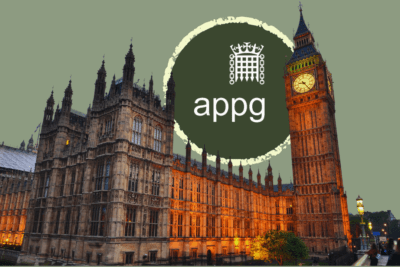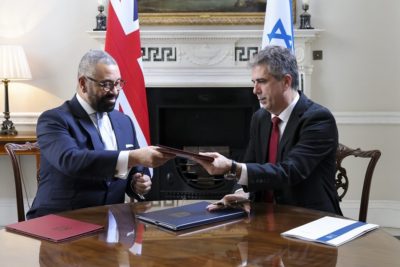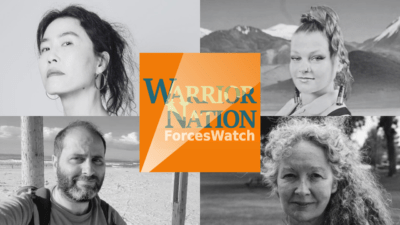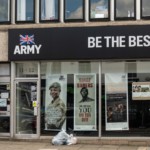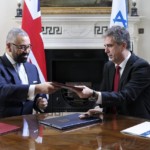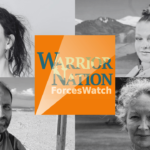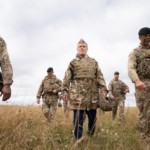Make Art Not War… or both?
Poppy Kohner
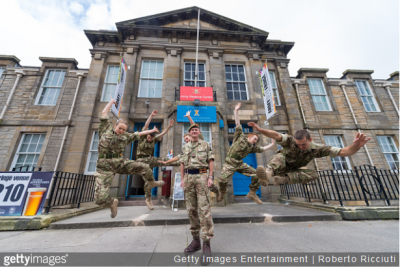
The Fringe festival has always been eclectic. Not an inch of Edinburgh is wasted as the whole city becomes a stage and all the people, merely players. But this year, on its 70th anniversary, the well-regarded Fringe venue Summerhall collaborated with a newcomer: the British Army. The Army Reserve Centre and Drill Hall in East Claremont Street transformed into a performance venue that was programmed and staffed by serving soldiers. This was billed as an opportunity to demystify the military, but should we be concerned that this particular kind of militainment is only the beginning of the Army’s engagement in the arts in Scotland and the UK?
I’m an anthropologist of militarism and a theatre-maker, so I felt I had to wonder down Leith Walk and make a visit to the drill hall-cum-theatre venue to take a closer look.
Many of the shows programmed by Army@theFringe dealt with subject matters such as race, gender, disability, mental illness and even imperialism. But here I am not interested in reviewing the shows as much as I am reviewing the politics of the Army hosting audiences at the Fringe.
#Army@TheFringe has started!! 2weeks of shows in @6SCOTS Reserve Centre from 11-26th August. Headlining is #5Soldiers by @rosiekaydanceco pic.twitter.com/8xA4IjYM2c
— The Army in Scotland (@ArmyScotland) August 11, 2017
On entering the drill hall I am greeted by soldiers. Lots of soldiers – more than are necessary. There is a relaxed, jovial, slightly disorganised atmosphere that is fairly welcoming. From the research I have done inside military bases the playful banter between soldiers on shift feels fairly familiar to me. Contrary to the marketed image of travel and adventure, being in the army usually entails a lot of waiting around.
I chat to a small crowd of friendly soldiers loitering in the entrance by the makeshift box office. I ask if they are paid any extra on their normal salary to staff the venue. “No,” they tell me, “but we volunteered to do it.” A Superior Officer catches wind of our conversation and strides between us with a brisk yet casual air of importance. He extends his finger in the air and without stopping or looking in my direction he bellows, “All our British soldiers are volunteers! Every single one of them wants to be here!” and continues to walk out the front door.
Compared to a larger conscription army, a volunteer force is easier to train, discipline, and retain. A smaller army also allows for public perception to be controlled by the military public relations team, as a smaller percent of the population actually experience army life. This notion of a professional army full of patriotic volunteers bolsters the cogency of the hero myth that makes up a central tenant of militarism. Once inside the military, individuals have a different (and limited) set of rights compared to civilians, and it is extremely difficult to leave once a contract is signed. In an era of austerity, increasing precarity, and the privatisation of social services such as higher education and healthcare, the army successfully presents itself as a fast track means towards social and economic mobility. So in response to the Superior Officer, how free is a choice between a vanishing number of options?
Inside the drill hall’s Mess there are Chesterfield sofas, a long table complete with tartan tablecloths, cut glass, candelabras, statuettes, trophies and other silver ornaments. The massive stuffed head of a caribou stares over us with glazed eyes and sprawling antlers, framed either side by pictures of Queen Liz and Prince Phillip. Despite all the twee, it feels sterile, solemn and stuffy.
Focusing on the person behind the uniform diverts the audience’s attention away from the Army as an institution. “Don’t worry about what we might be doing in the Middle East,” it says, “just remember: we’re people too.”
The exhibition at the venue was a celebration of soldiers in both training and operations, including a bigger-than-life-sized photograph of a small child in army camouflage crouching in long grass, without explanation. The Army were keen to assure me that this endeavor was not a recruitment exercise but about public engagement. Lt Col Jo Young, the British Army’s Officer for the Arts commented, “The impact of this is not something we can measure in terms of how many more people will join us as a result.” Lt Col Gordon McKenzie, head of public engagement, described it as “deepening the public understanding of who we are and what we do. So that people can know that behind the uniform we are also human beings”. But focusing on the person behind the uniform diverts the audience’s attention away from the Army as an institution. “Don’t worry about what we might be doing in the Middle East,” it says, “just remember: we’re people too.” In this way, the army’s engagement with the arts is a means to depoliticise the image of a soldier; a deeply political and strategic move.
Theatre is always in danger of becoming an apparatus of the state. Theatre operates on our sensibilities in ways that can evoke deep emotional responses and has the potential to change perceptions and consequential actions (or inaction). Aristotle called this catharsis: an empathetic connection towards the protagonist of a story, which, as the play comes to a resolution, arouses a potent mix of pity and fear in the hearts of the spectators.
Militarism is a kind of theatre in and of itself; a domestic military operation of public relations to recruit our hearts and minds. It communicates a simplified and highly censored story of British exceptionalism and moral righteousness of state sanctioned violence. It transforms violence into something to celebrate. The tragic heroes of this story are service members and we the civilians are a captive audience.
Lt Col Young commented that “Human spirit and human resilience is the common thread that runs throughout our programming. But we are also keen to have conversations with the public about what the forces looks like in the 21st Century. We want to show the public a different side of us. We are society’s army, and so its important that those we serve know about what the army does”.
My research has shown that there is often a disjuncture between imagined and lived military identities. As the protagonists in the narrative of militarism, soldiers and veterans are silenced by idealised notions of their lives and experiences. The more confounding and painful lived realities of post-9/11 military experience get blocked out by the noise of militarism and quickly become unspeakable, un-hearable and invisible. A romanticized public perception of military life can further injure soldiers who are trapped in a traumatic silence, unable to speak their contrary truths.
Public engagement exercises like the Army@TheFringe venue distance the military from the realities of what it does and disciplines the nation from critically engaging with war, and the implications of our arms trade.
Lt Col Young and her team are proud to act as programmers, and not actors, writers or directors. Over a gin and tonic Lt Col McKenzie told me that if they become the theatre makers they would be more vulnerable to criticism, but they are not ruling this out for the future. The narratives of militarism that we find at Army@theFringe presents the Army as being inclusive, diverse and open to dialogue. However there is something more at work – the claim to inclusivity conceals the fact that the Army@theFringe is a carefully constructed, morally manageable, imitation of the Army which is difficult to challenge.
Public engagement exercises like the Army@TheFringe venue distance the military from the realities of what it does and disciplines the nation from critically engaging with war, and the implications of our arms trade. “What is often missing from theatre and film depictions of the army” says Iraqi-British playwright Hassan Abdulrazzak “is the voice of those who are/were at the receiving end of military power, namely Afghani, Iraqi, Libyan and Yemeni civilians.”
This is a beginning of much wider programme of work orientated around military engagement in the arts. Army@theFringe is a part of worrying trend of the British military using US-style techniques of garnering public support for the troops. Some of these include the creation of Armed Forces Day in 2009, the commercialization of the Remembrance Poppy, army engagement in schools, learning packs that celebrate British military history for school children, increasing cadet forces across the UK, and a recruitment campaign that exploits young people’s desire to belong.
The Fringe is an open access festival, and this is important for nurturing creative freedom and expression, as was the ethos it was borne out of 70 years ago. I am not advocating censorship or blacklisting. However, this entanglement between the arts and the forces is an issue of censorship – we need to ask, what becomes censored when elite institutions take on the programming and hosting of the arts? Can we really expect to have a meaningful dialogue when the armed forces are calling the shots? How critical can embedded artists really be when in a relationship of gratitude to their military hosts?
The MoD did not have direct influence on four of the shows in their programme, with the exception of Rosie Kay’s dance company for their production of 5 Soldiers: the body is the frontline and the writers of Wired, who visited in the army for a period of time in the research and development stages of their creative process.
So what’s the pull for producers to choose the Army drill hall as the venue to host their show? Lt Col Young tells me that many of the costs involved in putting on a show at the Drill Hall have been subsidised and artists have been further helped out with access to free rehearsal space. The Army@theFringe have already started planning for next year’s Fringe noting in their brief that 2018 is designated Year of the Young Person by the Scottish Government. As part of their package to attract artists they have promised: to organise visits to Army bases or exercises to assist development of productions; access to rehearsal space in army halls across the UK; army personnel and musicians to take part in productions; promotional support from army media and marketing teams, including free distribution of leaflets by uniformed flyer teams; army accommodation being made available for the duration of shows, free meals for casts at the venue; and the possibility of being selected for post-Fringe tours of the Scotland and the UK, supported by the Army.
At these first stages of the British Armed Forces moving into arts engagement we have a moment to act. Now is the time for artists, writers, directors and arts organisations in the UK and Scotland to come together to make a collective and public declaration on the ethics of collaborating with the Army.
How to resist being seduced by these offerings that give emerging artists opportunities in a competitive arena like the Fringe? I wanted to ask Summerhall whether, in a time of escalating fear, xenophobia and military activity, is it not the responsibility of arts institutions to make choices that counter, not aide, a growing culture that idolises militarism and war? Despite leaving many messages and sending emails, I’m yet to get an answer.
Militarism operates in innocuous ways that normalise military imaginaries as a part of our everyday lives. At these first stages of the British Armed Forces moving into arts engagement we have a moment to act. Now is the time for artists, writers, directors and arts organisations in the UK and Scotland to come together to make a collective and public declaration on the ethics of collaborating with the Army.
Dr P Kohner is an anthropologist and has a PhD in Applied Social Science specializing in the anthropology of militarism and trauma from the University of Glasgow. She is also a co-founder of The Workers Theatre cooperative.
Also see We’re in the Army Now by Catrin Evans, published by Bella Caledonia, 1 August 2017
See more: military in society, culture
Like what you read?
> Sign up for our newsletter or blog notifications
> Support our work – from just £2 a month

